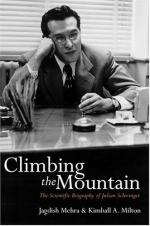|
This section contains 346 words (approx. 2 pages at 300 words per page) |
World of Scientific Discovery on Julian Seymour Schwinger
Schwinger was born in New York City on February 12, 1918. He entered the City College of New York at the age of fourteen, but soon transferred to Columbia. He earned his bachelor of arts degree three years later and his Ph.D. at the age of twenty-one. After graduation, he worked at the University of California at Berkeley under J. Robert Oppenheimer for two years. During World War II, he worked in the Manhattan Project at the University of California and at the Massachusetts Institute of Technology. At the war's conclusion, he was appointed to the faculty at Harvard and, in 1947, became full professor there, one of the youngest men ever to earn this honor.
Schwinger received a share of the 1965 Nobel Prize in physics for his research on quantum electrodynamics (QED). Basic QED theory had been developed in the 1920s by Paul Dirac, Werner Heisenberg, Wolfgang Pauli, and others. That theory aimed at describing the fundamental properties of subatomic particles and their interaction with electromagnetic fields. The theory had worked remarkably well for about twenty years, explaining every observation on the hydrogen atom.
In the 1940s, however, some contradictory evidence began to appear. For example, W. E. Lamb and R. C. Rutherford found in 1947 that one of the energy levels of the hydrogen atom is slightly different from that predicted by existing theory. In addition, Kusch and Foley discovered that the magnetic moment of the electron was slightly larger than had been predicted. Finally, existing QED theory led to some absurd and nonsensical predictions--such as particles of infinite or zero mass and charge--when applied to certain types of particles.
Schwinger was able to develop a new mathematical formulation that explained all of these phenomena. This formulation separated out a number of mathematical terms that had previously been combined in classical QED equations. Similar modifications and improvements of QED theory were being developed at essentially the same time by Richard Feynman and the California Institute of Technology and Sin-Itiro Tomonaga at the Tokyo University of Education, both of whom shared the 1965 Nobel Prize with Schwinger.
|
This section contains 346 words (approx. 2 pages at 300 words per page) |


